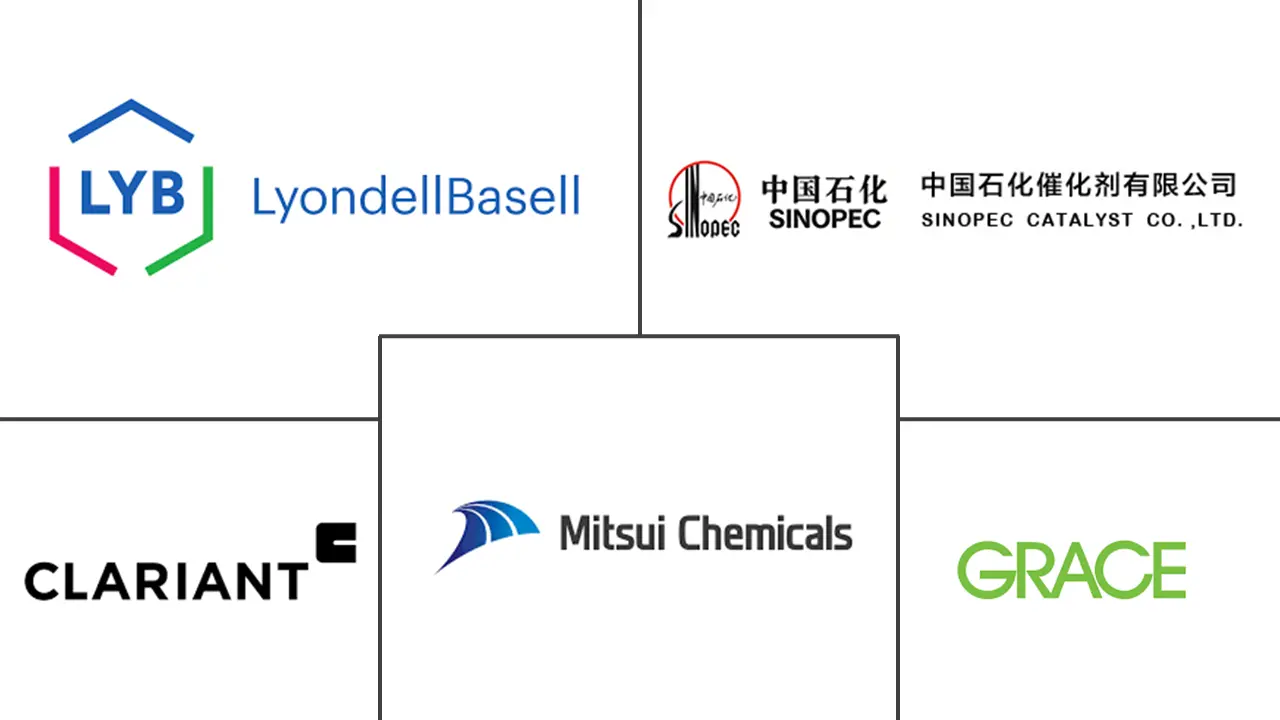Polypropylene Catalyst Market Size and Share
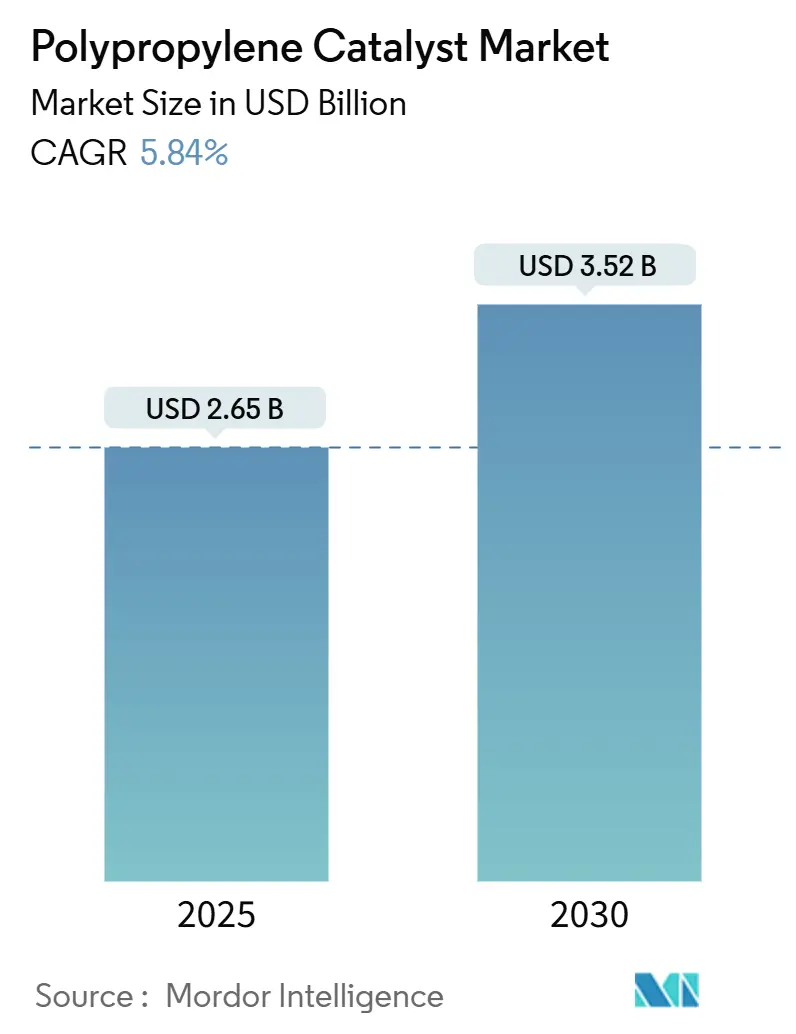
Polypropylene Catalyst Market Analysis by Mordor Intelligence
The polypropylene catalyst market is valued at USD 2.65 billion in 2025 and is forecast to expand to USD 3.52 billion by 2030, reflecting a 5.84% CAGR. Capacity additions in Asia-Pacific, swift adoption of phthalate-free technologies, and a steady pull from applications such as flexible packaging and medical devices reinforce near-term resilience. Robust e-commerce activity drives thin-wall packaging demand, while automotive lightweighting and additive-manufacturing grades open premium niches that favour metallocene and other high-performance systems. Intensifying industry consolidation—exemplified by Honeywell’s pending acquisition of Johnson Matthey’s Catalyst Technologies unit—signals a decisive push for scale and integrated R&D. Ongoing propylene price volatility and stricter global regulations on phthalates, however, continue to pressure margins and accelerate the shift toward novel catalyst formulations.
Key Report Takeaways
- By catalyst type, Ziegler-Natta systems led with 66.19% of polypropylene catalyst market share in 2024, whereas metallocene variants are projected to deliver the fastest 7.94% CAGR to 2030.
- By production process, gas-phase technology accounted for 47.08% of the polypropylene catalyst market size in 2024; hybrid/multi-reactor configurations offer the highest 6.57% CAGR through 2030.
- By application, the polypropylene segment captured 64.17% revenue share in 2024, advancing at the fastest CAGR of 8.42% through 2030.
- By end-user industry, packaging sustained its dominance in the polypropylene catalyst market share during 2024, yet healthcare underpins the steepest CAGR through the forecast window.
- By region, Asia-Pacific accounted for the largest share of 52.01% in 2024, and is expected to grow at the fastest CAGR of 6.95% through 2030.
Global Polypropylene Catalyst Market Trends and Insights
Driver Impact Analysis
| Driver | (~) % Impact on CAGR Forecast | Geographic Relevance | Impact Timeline |
|---|---|---|---|
| Capacity expansions in emerging PP hubs | +1.2% | Asia-Pacific core, spill-over to MEA | Medium term (2-4 years) |
| E-commerce-led surge in flexible packaging demand | +0.8% | Global, with concentration in North America & APAC | Short term (≤ 2 years) |
| Automotive lightweighting initiatives | +0.6% | North America & EU, expanding to APAC | Long term (≥ 4 years) |
| Regulatory shift toward phthalate-free catalysts | +0.7% | Global, led by EU and North America | Medium term (2-4 years) |
| In-house catalyst recycling & regeneration | +0.4% | Developed markets, gradual APAC adoption | Long term (≥ 4 years) |
| High-melt-flow PP for additive manufacturing | +0.3% | North America & EU, niche APAC segments | Long term (≥ 4 years) |
| Source: Mordor Intelligence | |||
Capacity Expansions in Emerging PP Hubs
Ongoing megaprojects, such as SABIC’s USD 6.4 billion Fujian Petrochemical Complex slated for 2026 commissioning, illustrate how large-scale investments are redefining regional supply nodes and pulling through catalyst demand at massive volumes[1]SABIC, “SABIC To Build Fujian Petrochemical Complex,” sabic.com. China alone plans 26 million tons of new ethylene capacity between 2023 and 2027, tilting global balances and compelling catalyst producers to localize manufacturing footprints to capture freight and service advantages[2]Nikkei Asia, “Japan Ethylene Output Hits 35-Year Low,” nikkei.com. This expansion also heightens oversupply risk, forcing older crackers in Japan and parts of Southeast Asia to slow or suspend operations. As Gulf producers build domestic catalyst capabilities, proprietary know-how is becoming pivotal to sustain cost leadership and differentiate in tight-margin environments.
E-commerce-Led Surge in Flexible Packaging Demand
A sharp rise in online retail continues to swell thin-wall packaging volumes. Asia-Pacific remains the largest consumption zone as China and India expand packaging lines to serve urbanizing populations. Brands are mandating fully recyclable solutions, steering investments toward high-melt-strength PP grades and non-phthalate catalysts that improve clarity and stiffness while satisfying regulatory thresholds. Capacity build-outs, however, have outpaced demand in India, trimming average industry operating margins to near-decade lows and underscoring the sector’s cyclical character.
Automotive Lightweighting Initiatives
Original equipment manufacturers are shifting aggressively toward lightweight plastics to compensate for heavier electric-vehicle battery packs. High-melt-flow PP foams produced with sophisticated metallocene or modified Ziegler-Natta catalysts support complex geometries and crash-resistance targets. Recent investments exceeding EUR 100 million to triple Daploy high-melt-strength PP capacity in Europe highlight technology leverage in this arena. Catalyst suppliers must deliver tight molecular-weight distributions and narrow comonomer incorporation windows that enable low-density foams without sacrificing impact strength, opening premium pricing latitude despite feedstock headwinds.
Regulatory Shift Toward Phthalate-Free Catalysts
The European Union’s Regulation (EU) 2025/351 introduces stringent migration limits and traceability requirements that effectively steer the global industry away from phthalate ester donors[3].European Commission, “Regulation (EU) 2025/351,” eur-lex.europa.eu China’s January 2026 RoHS revisions impose ≤ 0.1% by-weight phthalate caps, accelerating the adoption of sixth-generation non-phthalate solutions such as W.R. Grace’s CONSISTA C601 platform. Catalyst vendors are pivoting R&D to balance activity, stereospecificity, and regulatory compliance, while polypropylene producers face line-conversion costs and temporary output inefficiencies.
Restraint Impact Analysis
| Restraint | (~) % Impact on CAGR Forecast | Geographic Relevance | Impact Timeline |
|---|---|---|---|
| Stringent global bans on phthalate donors | -0.9% | Global, led by EU and North America | Medium term (2-4 years) |
| Propylene price volatility | -1.1% | Global, acute in North America & EU | Short term (≤ 2 years) |
| Scarcity of tri-ethyl-aluminium supply | -0.6% | Global, concentrated in Asia-Pacific | Medium term (2-4 years) |
| Source: Mordor Intelligence | |||
Stringent Global Bans on Phthalate Donors
Expanded chemical-safety frameworks in the EU, China, and select US states are driving expensive compliance upgrades, including on-line spectroscopic monitoring and enhanced traceability protocols for non-intentionally added substances. The transition to phthalate-free catalysts often requires higher co-catalyst loadings and refined reactor conditions, escalating production complexity and capital expenditure for many operators.
Propylene Price Volatility
Propylene benchmarks remain prone to supply shocks from refinery rationalizations and cracker outages. US polymer-grade propylene is expected to rise by 5 ¢/lb into mid-2025 as new polypropylene plants ramp while refinery cuts tighten feedstock pools. Similar gyrations in Asia, aggravated by uneven LPG flows, complicate inventory and pricing strategies for catalyst makers tethered to contractual pricing formulas linked to propylene indices.
Segment Analysis
By Catalyst Type: Metallocene Gains Despite Ziegler-Natta Dominance
Ziegler-Natta catalysts held 66.19% of the polypropylene catalyst market share in 2024 because of proven efficiency and broad application compatibility. The polypropylene catalyst market size for metallocene variants is projected to expand at a 7.94% CAGR, reflecting their precision in molecular architecture and compliance with phthalate-free mandates. Innovations such as chromophore quench-labelling indicate meaningful headroom to raise active-site utilization, boosting catalyst output per pound of titanium and shrinking total installed costs. Producers are thus running dual portfolios: cost-efficient Ziegler-Natta grades for mass market volumes, and metallocene lines for premium clarity film, medical, and automotive projects.
In competitive terms, W.R. Grace’s sixth-generation CONSISTA C601 non-phthalate Ziegler-Natta catalyst bridges regulatory compliance and optical performance, challenging metallocene incumbents in high-clarity packaging. The resulting overlap is intensifying price-performance comparisons across customer accounts, prompting fresh licensing deals that bundle catalyst offerings with process automation software.
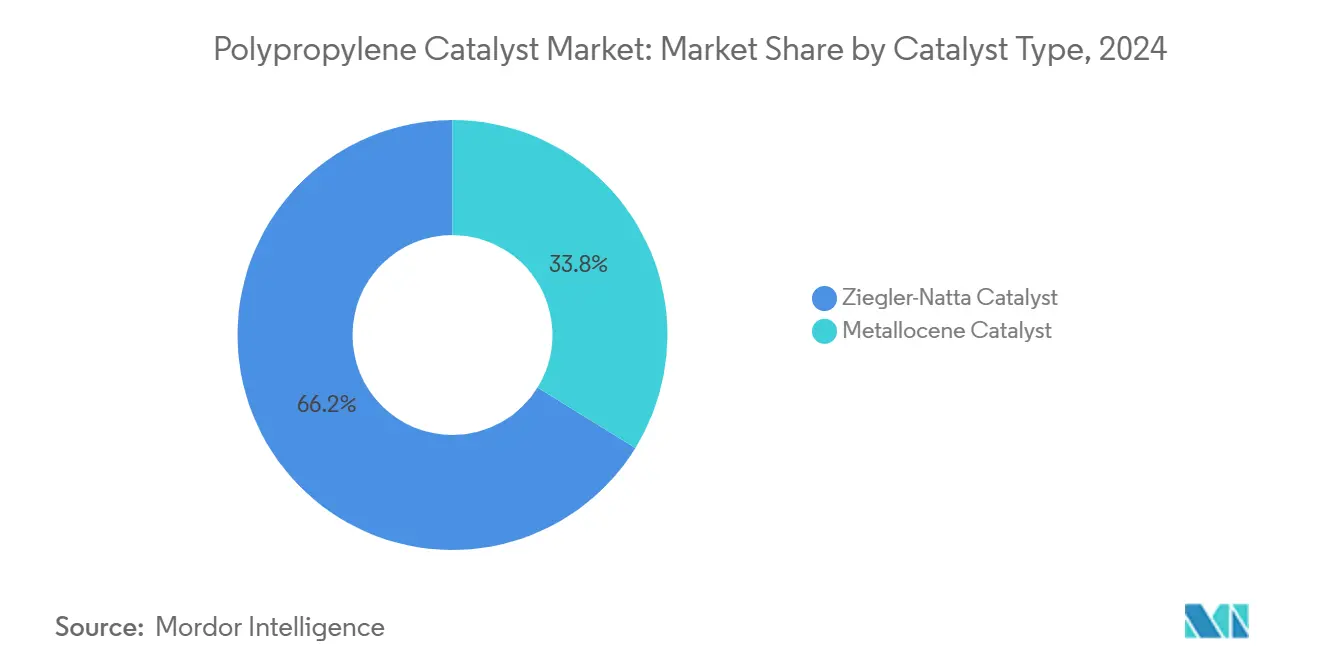
Note: Segment shares of all individual segments available upon report purchase
By Production Process: Gas Phase Leads Amid Hybrid Innovation
Gas-phase technology captured 47.08% of the polypropylene catalyst market share in 2024, owing to low capital intensity, modular debottlenecking, and short start-up timelines. The polypropylene catalyst market size attributed to hybrid bulk-loop/gas lines is forecast to grow at 6.57% CAGR through 2030 as producers install sequential reactors capable of toggling between homopolymer and impact-copolymer grades without major downtime. These twin-reactor schemes maximise catalyst residence-time efficiency and fine-tune block comonomer distribution for property gradation.
Bulk loop-slurry and slurry-phase routes persist in niche domains where melt-index control and narrow molecular-weight dispersions override cost arguments. Process licensors are therefore leveraging data analytics and catalyst-specific digital twins to help operators execute grade swings swiftly, minimising off-spec resin and raising plant utilisation in volatile demand cycles.
By Application: Polypropylene Dominance Reflects Market Maturity
Polypropylene production itself accounted for 64.17% of global catalyst demand in 2024, yet it also logs the swiftest 8.42% CAGR to 2030, underscoring continued substitution into polyolefin blends and new recyclate streams. High-clarity random-copolymer film, thin-wall injection moulding, and thermoform sheets dominate capacity expansions, sustaining a feedback loop of catalyst innovation focused on comonomer distribution, peroxide-free melt-flow tuning, and low-residue ash profiles.
Sustainability imperatives are injecting new life into recycling-compatible catalysts. Purification systems such as Clariant’s HDMax line, deployed to upgrade pyrolysis oils, require propylene catalysts tolerant to trace olefinic impurities while delivering on-spec molecular weight. These specifications push vendors to pioneer highly selective, poison-resistant formulations.
By End-User Industry: Healthcare Emerges as Growth Driver
Packaging maintained a 49.06% share of the polypropylene catalyst market size in 2024, reflecting a reliable pull from food safety regulation and e-commerce. Healthcare, however, lead growth at 7.19% CAGR. Hospitals and device makers demand resin grades meeting USP Class VI and ISO 10993 biocompatibility, translating into catalyst purity thresholds below parts-per-billion on heavy-metal residues. Suppliers are co-engineering metallocene catalysts with melt-blown non-woven producers to ensure sterilisability and kink-resistance in surgical gowns and syringe barrels.
Automotive interiors and under-hood applications continue to evolve toward foamed structures as OEMs shave vehicle mass to offset battery weights. Catalysts enabling high-melt-strength PP are therefore in tight supply, signifying a potential price up-cycle despite overarching commoditisation trends.
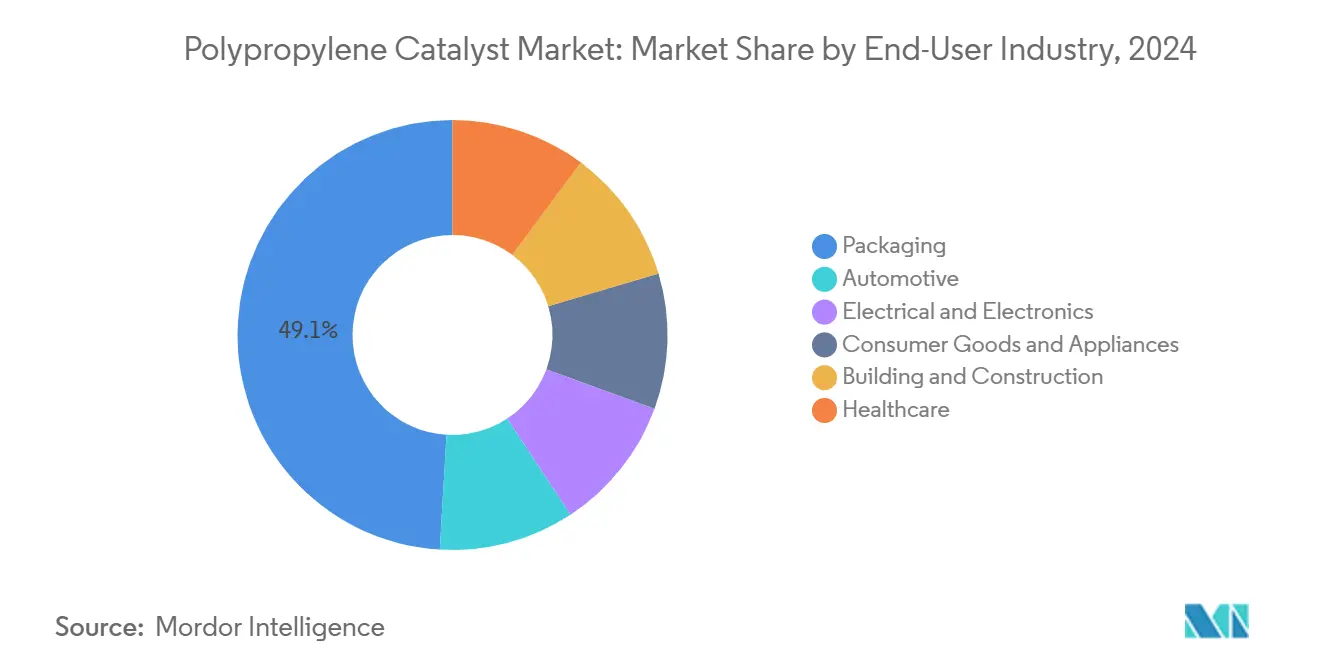
Note: Segment shares of all individual segments available upon report purchase
Geography Analysis
Asia-Pacific retained 52.01% share of global revenue in 2024 and is growing at 6.95% CAGR, underscoring its status as the axis of new capacity and demand. Government-backed complexes such as the SABIC Fujian project will anchor localized supply chains, while India’s petrochemical roadmap forecasts USD 350–370 billion of consumption by 2040, signifying multiple world-scale facilities across the subcontinent. Excess capacity from Chinese builds, however, is rippling across Japan and other mature markets, prompting strategic shutdowns of ageing crackers.
North America remains a technology hub, buoyed by feedstock optionality from shale gas liquids. LyondellBasell’s propylene oxide complex and associated polypropylene debottlenecks in Texas reinforce regional demand for advanced Ziegler-Natta and metallocene systems fit for food-contact and healthcare applications. Yet refinery rationalisation constricts propylene pools, amplifying spot-price swings that challenge inventory planning.
Europe, though facing elevated energy costs, charts policy leadership in circularity. The EU’s food-contact amendment and national plastic taxes spur adoption of phthalate-free catalysts and high-MFR resins suited to mechanical recycling loops. Borealis’ EUR 100 million outlay to triple Daploy capacity in Germany underlines niche specialisation in value-added grades. Middle East and Africa, leveraging advantaged feedstocks, is scaling specialty polyolefin complexes, while South America advances more modest brownfield debottlenecks to match domestic consumption.
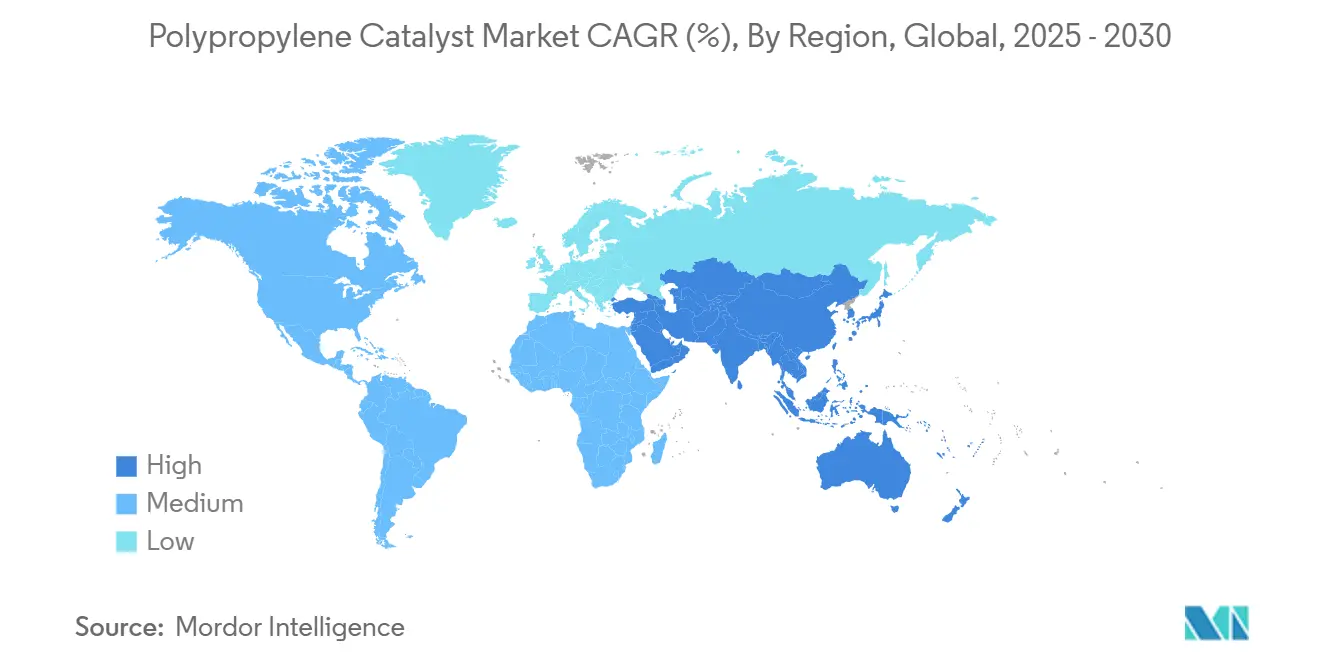
Competitive Landscape
The polypropylene catalyst market shows moderate concentration. Incumbents are doubling down on phthalate-free and recycling-ready innovations. Grace and Milliken co-developed additive-catalyst packages that cut cycle times and raise clarity in random-copolymer containers. Clariant’s HDMax catalysts and CLARIT adsorbents enable chemical recycling streams to meet polymerisation purity specs, reflecting a broader pivot toward circular-economy profit pools. Emerging disruptors focus on AI-driven catalyst discovery, yet face high qualification barriers at commercial scale.
Polypropylene Catalyst Industry Leaders
-
Clariant
-
LyondellBasell Industries Holdings B.V.
-
Mitsui Chemicals, Inc.
-
Sinopec Catalyst CO.,LTD.
-
W. R. Grace & Co.
- *Disclaimer: Major Players sorted in no particular order
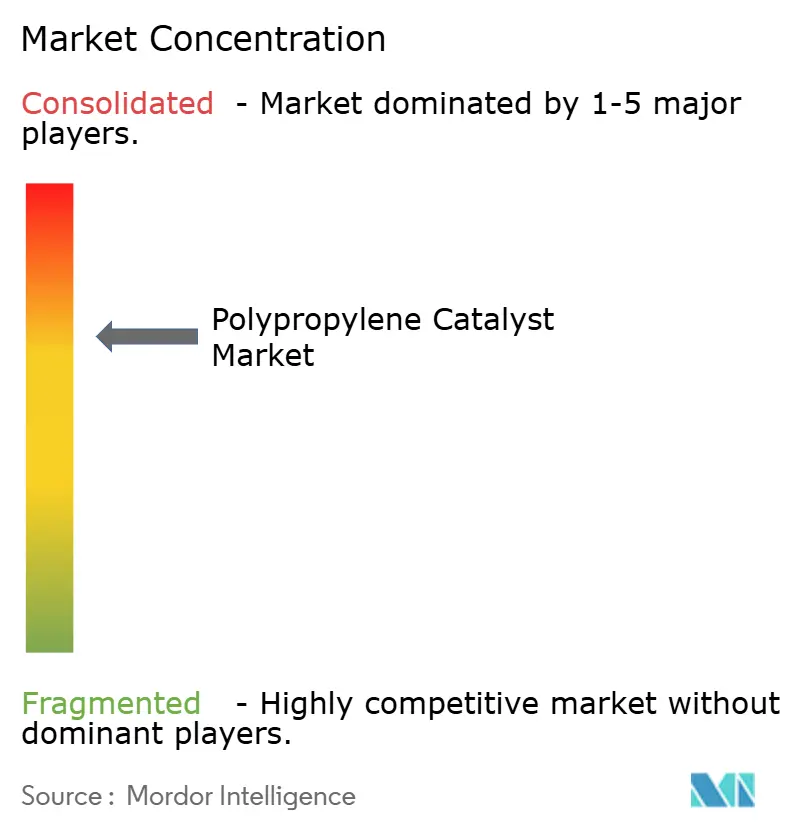


Recent Industry Developments
- November 2024: W. R. Grace & Co. (Grace) announced the commissioning of Nayara Energy Limited's kilotons per annum (KTA) UNIPOL PP process technology plant in Vadodara, Gujarat, India. The plant uses Grace's non-phthalate CONSISTA catalysts and UNIPOL UNIPPAC software to produce PP grades for pharmaceutical, health, and hygiene applications.
- May 2023: LyondellBasell announced that Alujain National Industrial Company (Alujain) selected its Spherizone technology and polypropylene catalysts for a 500 KTA polypropylene line in Yanbu, Saudi Arabia. The line will be operated by Alujain's subsidiary, Alujain National Industrial Company.
Research Methodology Framework and Report Scope
Market Definitions and Key Coverage
At Mordor Intelligence, we define the polypropylene catalyst market as every commercial Ziegler-Natta, metallocene, or novel single-site system supplied in solid or supported form to polymerize propylene in loop, slurry, bulk, or gas-phase reactors. We count merchant sales and the imputed value of catalysts consumed captively inside integrated petrochemical complexes.
Scope Exclusion: Catalysts dedicated solely to polyethylene, olefin block copolymers, pilot plants, or laboratory synthesis are outside this study.
Segmentation Overview
- By Catalyst Type
- Ziegler-Natta Catalyst
- Metallocene Catalyst
- By Production Process
- Bulk (Loop-Slurry) Process
- Gas-Phase Process
- Slurry Phase
- By Application
- Polypropylene
- Other Applications
- By End-User Industry
- Packaging
- Automotive
- Electrical and Electronics
- Consumer Goods and Appliances
- Building and Construction
- Healthcare
- By Geography
- Asia-Pacific
- China
- India
- Japan
- South Korea
- Rest of Asia-Pacific
- North America
- United States
- Canada
- Mexico
- Europe
- Germany
- France
- United Kingdom
- Italy
- Rest of Europe
- South America
- Brazil
- Argentina
- Rest of South America
- Middle East and Africa
- Saudi Arabia
- South Africa
- Rest of Middle East and Africa
- Asia-Pacific
Detailed Research Methodology and Data Validation
Primary Research
We spoke with process engineers at polypropylene units, procurement managers at film and fiber converters, and regional catalyst distributors across Asia-Pacific, North America, Europe, and the Middle East. Their insights refined yield assumptions, start-up ramps, and average selling price spreads that desk material alone could not confirm.
Desk Research
Our team compiled baseline volumes from trade data issued by UN Comtrade, reactor license filings visible on the US EPA and EU REACH portals, and annual production bulletins from the International Energy Agency and China's National Bureau of Statistics. Patent landscapes pulled through Questel traced the shift toward phthalate-free donors. Company 10-Ks, investor decks, and regional capacity surveys hosted on D&B Hoovers, Dow Jones Factiva, and Asia Metal revealed start-up timelines and realized selling prices. The sources named illustrate the mix; numerous additional publications informed data checks and clarifications.
Market-Sizing & Forecasting
The model begins with a top-down and bottom-up loop. Annual polypropylene output by reactor type is rebuilt from propylene balances and utilization rates, then multiplied by typical catalyst productivity factors to derive demand. Supplier shipment roll-ups and channel checks validate totals, with small adjustments where gaps appear. Key variables tracked include propylene contract prices, fresh PDH capacity, metallocene penetration, average catalyst dose rates, regulatory phase-outs of phthalate donors, and e-commerce driven packaging growth. Forecasts rely on multivariate regression blended with scenario analysis vetted by our primary contacts. Plant-level missing values are bridged with region-specific productivity coefficients confirmed in follow-up calls.
Data Validation & Update Cycle
Mordor analysts flag variances exceeding five percent between quarterly indicators and model runs, then revisit sources before sign-off. Reports refresh each year, yet material policy shifts or force majeure events trigger interim updates so clients receive a current view.
Why Our Polypropylene Catalyst Baseline Stays Reliable
Published figures often diverge because firms choose different catalyst scopes, apply contrasting ASP deflators, or refresh on uneven cadences. Our approach, anchored to verified 2024-2025 plant start-ups and rolling exchange rates, avoids those pitfalls.
Main gaps arise when captive catalyst consumption is ignored, metallocene uptake is overstated, or currency conversions lock to a single year. Mordor's methodology adjusts for each factor, producing a balanced baseline that decision-makers can trust.
Benchmark comparison
| Market Size | Anonymized source | Primary gap driver |
|---|---|---|
| USD 2.65 billion (2025) | Mordor Intelligence | |
| USD 2.50 billion (2025) | Global Consultancy A | Assumes instant global metallocene penetration without verifying supply pipeline |
| USD 2.23 billion (2024) | Industry Journal B | Relies on historical resin output, overlooks new Asian debottlenecking and catalyst grade shifts |
| USD 2.48 billion (2025) | Regional Consultancy C | Uses uniform ASP deflator and omits captive consumption at integrated complexes |
Taken together, the comparison shows that our measured scope, documented variables, and disciplined refresh rhythm provide the most transparent and dependable baseline for strategic planning.


Key Questions Answered in the Report
What is the current Polypropylene Catalyst Market size?
The market stands at USD 2.65 billion in 2025 and is projected to reach USD 3.52 billion by 2030.
Which region leads polypropylene catalyst demand?
Asia-Pacific accounts for 52.01% of global revenue due to extensive capacity additions and rapid downstream consumption.
Which catalyst type is growing fastest?
Metallocene catalysts post the highest 7.94% CAGR, driven by superior property control and regulatory compliance advantages.
How does propylene price volatility influence the market?
Fluctuating propylene costs squeeze producer margins and compel flexible pricing and inventory strategies for catalyst suppliers.
Page last updated on:
